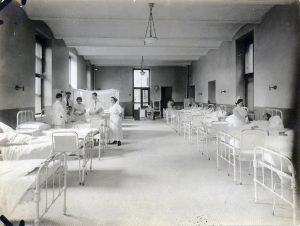An update to this blog post can be found here.
Founded in 1892, the early history of Mount Sinai Beth Israel Hospital was decorated with a series of success stories in the treatment of disease. Against the background of Manhattan’s Lower East Side, then affected by poverty, close living quarters, and dangerous working conditions, its residents, largely recent Jewish immigrants, were made vulnerable to many of the contagious diseases of that era. In its first years, Beth Israel contributed research to combat the typhoid epidemic of 1906-1907, established an after-care clinic to children affected by the 1916 polio epidemic, and is credited with finding the cure for trachoma, which had previously been a cause to turn away new immigrants at Ellis Island.
Only twenty-five years after Beth Israel’s opening, the United States was embroiled in the first World War. The Hospital encouraged its medical staff to join the Medical Reserve Corps, with approximately half of its doctors signing up. The Hospital had also encouraged its nurses, physicians and other staff to join the war effort.
This left Beth Israel in a precarious position when the 1918 Influenza epidemic reached New York City. Being chronically understaffed, Beth Israel’s Medical Board contacted the Department of Health for advice. The response was simply: “There is nothing to advise except the use of gauze masks which did not always prevent the disease.” In November 1918, the Hospital eliminated visiting hours, curtailed teaching hours, and turned the Male Medical Ward over to the Department of Health to use as an isolation facility for the pandemic. (The DOH never used the facility because they were similarly understaffed.)

Female ward of Beth Israel Hospital, Jefferson and Cherry Street, circa 1910
Ultimately, Beth Israel was only able to admit twenty-nine influenza patients. (Update: This number is disputed in other sources.) Seven members of the House Staff were awarded $25 (approximately $500 today) for “self-sacrificing services performed” and the Hospital offered special incentive pay to doctors and nurses to help combat the fact that they were understaffed.
Despite the limited patient intake, Beth Israel’s contributions to the 1918 flu pandemic were still impactful. In December 1918, Superintendent of the Hospital, Louis J. Frank, contacted Presidents Roosevelt and Taft to encourage universal nursing training in the education of women, likely in response to the chronic under-staffing at this time. By January 1919, many of the patients in the Hospital were admitted for “post-influenzal complications” leading to the care of many affected by the pandemic.
Sources:
- Beth Israel Medical Center. The First Hundred Years: Beth Israel Medical Center. 1990. p. 35 – 36.
- Pettit, Dorothy Ann. A Cruel Wind: America Experiences Pandemic Influenza, 1918-1920, A Social History. Winter 1976. p. 201, 215.
Authored by Stefana Breitwieser, Digital Archivist
